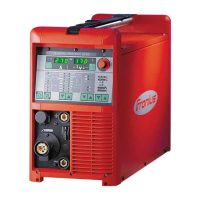48
Function over-
view
- Basic composition: two individual power modules (advantage: power modules can
be switched in series as well as parallel)
- Suitable for a 3 x 400 V AC and 3 x 230 V AC mains supply
- Inputs and outputs are electrically isolated by means of isolating transformers and
optical couplers
- 3 temperature sensors, each one in the transistor module housing
- Temperature analysed by a PWM signal electrically isolated by an optical coupler:
the temperature of the warmest transistor module is transmitted to the UST PC
board
- Monitoring of both intermediate circuits for imbalance: a signal is transmitted to the
UST PC board if there is any deviation from a permitted range
- Switching with boost converter for increasing the intermediate circuit voltage from
approx. 282 V DC to 320 Volt DC per circuit (at 400 V AC input voltage).
- Controlling the transistor module via driver stages from the UST PC board
- High charging connection via PTC resistors, time for bridging the PTC by means of
relay is given by UST PC board
- Activation of boost converter only once the high charging time is completed
- Quick switch-off of power module in the case of a module fault due to permanent
primary current measurement
Technical Data
Input voltage 3 x 230/400 V AC
Input voltage tolerance (+/-15%)
Supply voltage (from NT 24A) 15 V DC primary
Boost converter work frequency 47 kHz
Transistor module switching frequency 100 kHz
Plug layout BPS
25/BPT 27
(X13) (X14) (X10) (X4)
(X3)
(X9)
(X6)
(X11)
(X5)(X12)(X2)(X15)(X16)
(X1)
Fig. 15 Plugs and connections on PC board BPS 25/BPT 27
(X7)
(X8)

